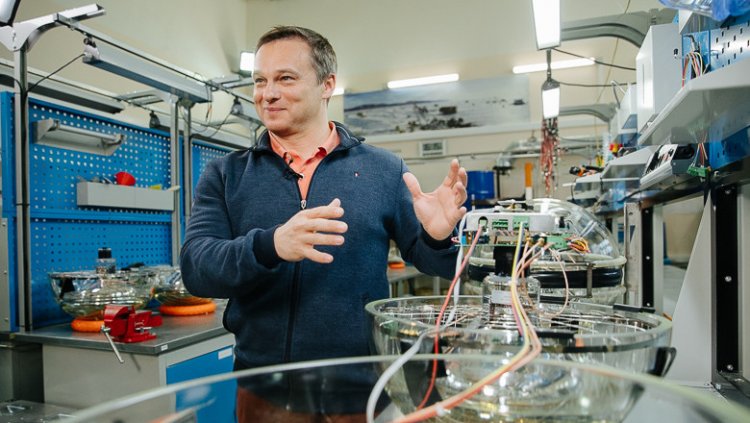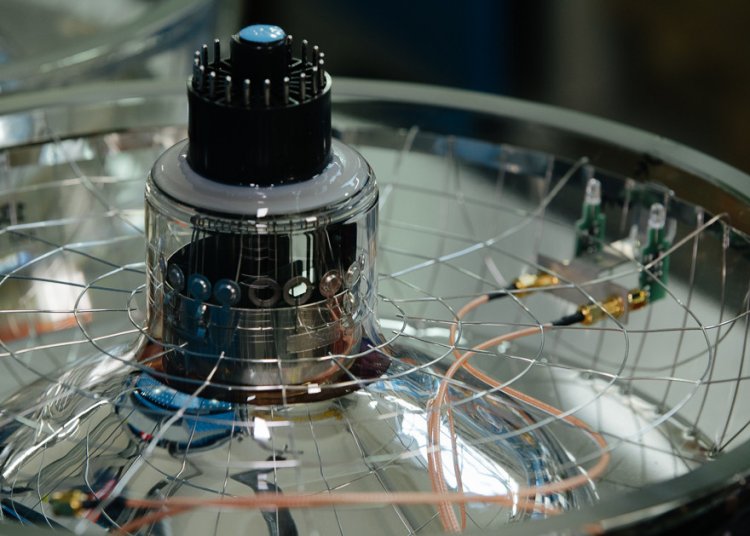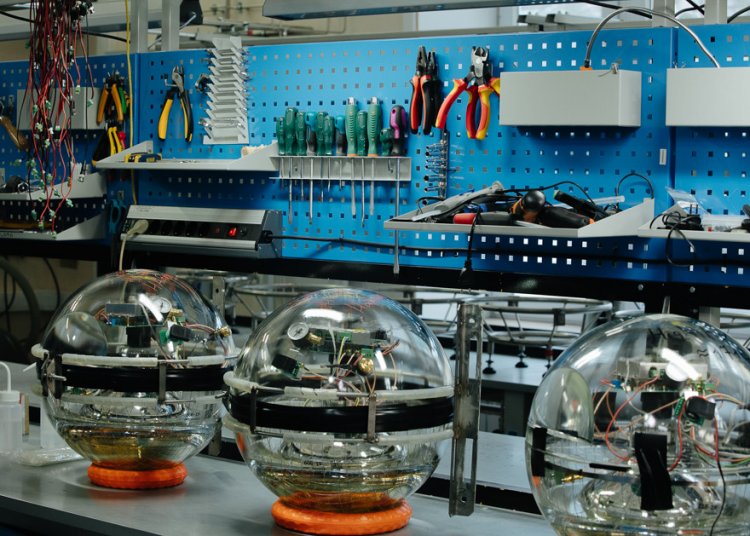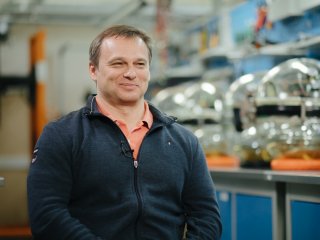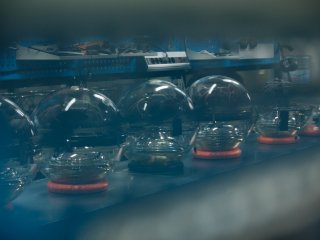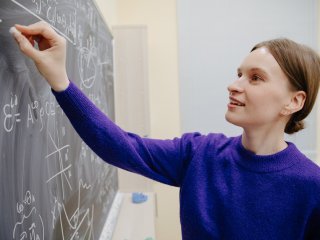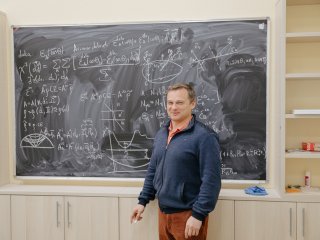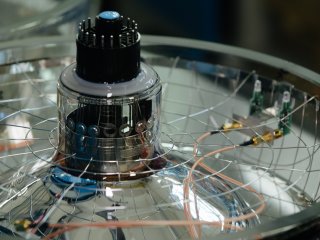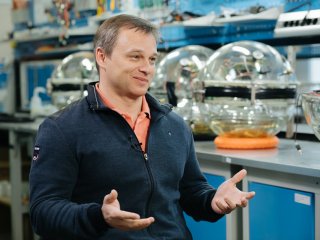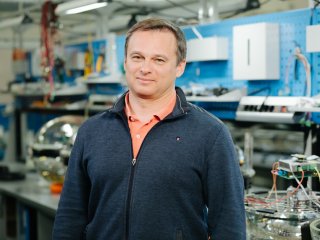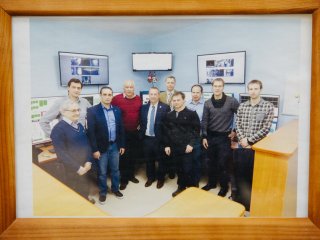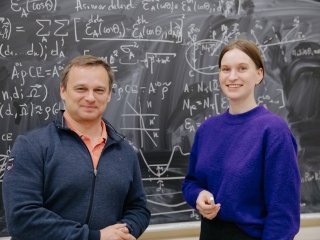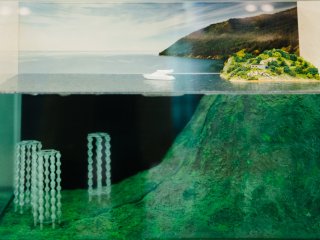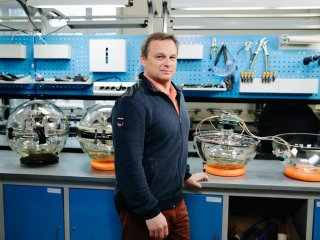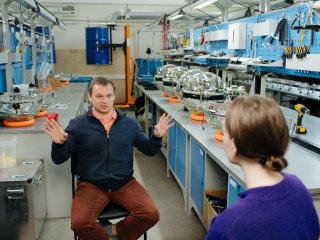While you read these lines, billions of neutrinos are flying through your body. Some of them were born inside the Sun; others generated in the atmosphere or traveled from some far corner of the universe. Naturally, you have noticed nothing being unable to see these particles. There are no barriers for neutrinos. They have no electric charge and features extremely low weight. That is why neutrinos thrust through everything on their way – human bodies, stars and planets – without any visible consequences. Some 100 years ago, the very existence of neutrino looked impossible. Today, large neutrino observatories are brought together into a single network to solve the mysteries of this elusive particle. How did the physicists of 20th century save the laws of energy and momentum conservation? Why are neutrino observatories being built in the Antarctic, on the bottom of Baikal and waters of Mediterranean? The answers are offered by Dmitry Naumov.
Dmitry Naumov, Deputy Director for Science of the Nuclear Problems Laboratory at the Joint Institute for Nuclear Research (JINR), Head of Neutrino Program of JINR.
Photo: Nikolay Mokhnachev/Scientific Russia
— Neutrino is called a mysterious particle. Why?
— Neutrino was generated with the point of a pen. This particle was invented by Austrian theoretician Wolfgang Pauli who made a desperate attempt to save the laws of energy and momentum conservation back in 1930. Let me remind you that not all of atomic nuclei are stable. Some of them decompose. Three types of radioactive decay are known – alpha, beta and gamma ones. Today, we understand that they are caused by three fundamental interactions – electromagnetic, weak and strong respectively. During the beta-decay the nucleus changes its charge generating electron or positron. From the point of view of energy and momentum conservation laws, the energy and momentum of initial decay should be equal to the sum of energy and impulses of all decay products. However, it was discovered during the experiments with beta-decay (by the way, it took some time to recognize this fact) that it is not true. The electrons featured almost any energy values between zero and some positive value. On the other hand, the laws of energy and momentum conservation were valid in case of electromagnetic or strong interaction. As for beta-decay, such a strange problem would always occur.
It became a real headache for the physicists, and the process of solving this problem lasted for more than a decade. Outstanding scientist Niels Bohr even suggested refusing from conservation laws on some level of nature description. This idea looked extremely wild to Wolfgang Pauli, and it was good! He set forth an idea of one more particle emerging and flying away in the process of nuclear fission. It is electrically neutral, so electromagnetic instruments cannot record it. Besides, it should feature weak interaction, otherwise it would have been registered by detectors, and its traces would have been found. Today, this idea seems simple and clear, but in 1930s it was a revolutionary one.
Pauli understood that his idea would come under strong criticism and believed that nobody could ever confirm the existence of this particle. He did not even have the heart to highlight his idea openly at the conference. The scientist wrote a letter to the participants of the conference that began with words, “Dear radioactive Ladies and Gentlemen!” In this letter, he highlighted his hypothesis and brought apologies for being unable to participate in the conference due to being obliged to attend a dancing party in Zurich.
Initially, Pauli called this elusive particle a neutron. Today we know that neutron is a heavy enough particle which takes part in strong interaction, i.e. completely fails to fit the description. The fact was that neutron was not yet discovered at the moment of Pauli’s letter being written. Only in 1932, British scientist James Chadwick managed to discover neutron whose existence had been predicted by Soviet physicist Dmitry Ivanenko and German scholar Werner Heisenberg. Chadwick himself believed in the atomic nucleus containing some other particles apart from proton. Word neutrino (the Italian for small neutron) was suggested by Italian physicist Enrico Fermi who formulated the first quantitative theory of beta-decay. The scientist described the interaction of four particles in it: proton, neutron, electron and neutrino.
Starting from this very moment, the physicists began studying neutrino trying to identify the probability of its interaction. It has turned out that this particle features such a weak interaction that it is almost impossible to register it. For instance, one will have to flood with lead (Pb) the whole space located between the Earth and Alpha Centauri in order to catch half of all neutrinos emitted by the Sun. Thus, the physicists would consider neutrino a ghost particle for a long time. Many of them agreed that it existed, yet did not know how to work with it.
— It is because it features weak interaction, isn’t it?
— Right.
— Pauli was even ready to bet champagne the particle would not be discovered.
— Yes.
— However, he was mistaken, wasn’t he?
— Actually, it was a thought-out bet. Judge for yourself: if he lost the bet (now we know that he lost it), his name would have his name written in the history of physics forever, so the price of a box of champagne seemed a trifle if compared to such an achievement. If he won the bet, he would get a box of champagne free of charge. Thus, he would stand to gain in any case. By the way, when Pauli received the telegram from future Nobel Prize winner Frederick Reines and Clyde Cowan (who unfortunately failed to live up to the Nobel Prize), he immediately invited his friends-theoreticians, and they drank this box of champagne, so the experimentalists got nothing.
Details of photo-amplifier
— They received the Nobel Prize.
— Yes, but unfortunately not all of them. One should be not only clever, but healthy as well to live up to the Nobel Prize.
— Caution tale. What is known about neutrino sorts today? Why do physicists call them flavors?
— One should say that physicists often have a good sense of humor and like to invent funny names. That is why neutrinos have flavors which have nothing to do with odor, while quarks have colors which have nothing to do with color.
Let us come back to neutrino sorts. Today we identify three neutrino sorts or flavors. Where did these flavors come from? Let me begin with the fact that there are three charged leptons – electron, muon and tau-lepton. They interact is a very similar manner, but muon is heavier than electron by almost 200 times, while tau-lepton is heavier than muon by almost 17 times. As it has turned out, there are three different types of neutrino. In case of weak interactions, neutrino is always generated together with some charged lepton of the same sort or flavor, if we speak in terms of science. For instance, the electron is generated together with electron anti-neutrino, muon is accompanied by muon one, while tau-lepton – by tau-neutrino. Reliable evidence of the fact that there are exactly three flavors has been found experimentally by way of analyzing disintegration probability of another particle bearing the name of Z-boson – a neutral particle and one of weak interaction carriers. Z-boson is instable and by almost 90 times heavier than proton. Z-boson disintegrates into many different particles including a pair of neutrino and anti-neutrino. The respective probability is easily assessed theoretically. It is clear that as there are three neutrino flavors three times greater probability of Z-boson’s disintegration into a pair of neutrino and antineutrino in total corresponds to them. That is why the comparison with experiment allowed for establishing that the number of neutrino types is equal to three.
— What about sterile neutrinos?
— It is good that you have got so well prepared for our conversation! In 2012, the physicists faced a new mystery. It is known that anti-neutrinos are generated in abundance in nuclear reactors. It has turned out that measurements how deficit which cannot be explained by oscillations of neutrino – a very important effect predicted by Bruno Pontecorvo working in Dubna. The confirmation of this effect brought to the Nobel Prize in physics to Takaaki Kojita and Arthur McDonald in 2015. It is impossible to explain the rector deficit by oscillations of three neutrinos. What about four of them? If there were four neutrino flavors, it would be possible. However, Z-boson provided reliable evidence that there are three types, not four! What to do? An artful hypothesis was suggested saying that along with the said three neutrino generations one more type exists – sterile neutrino. If the neutrinos we know show poor interaction, the sterile one does not interact at all! That is why the existence of sterile neutrinos does not disagree with Z-boson’s disintegration probability observed. Moreover, in the process of oscillations the known neutrinos are in sterile state for some time. If they are caught by detector in this state, the deficit of neutrino interactions is observed. An ingenious idea indeed with deep implications! In particular, such neutrinos may appear in cosmology. Yet today, this assumption disagrees with the experiment. Though the idea looks interesting, it can hardly be translated in nature, at least in such a way.
— Where does the deficit come from?
— The wrong nuclear model predicting neutrino flows was likely to be used. It is not an easy problem, as neutrinos are generated in reactor in hundreds and even thousands of ways.
— How do neutrino observatories work? How can an elusive thing be caught?
— One has to create something that can be caught to catch an elusive thing. It is impossible to see neutrino as it is. So other particles are required, the ones that leave electric traces in detector. Simply put, neutrino enters the detector and generates a particle that can be registered. These may be muons, protons and other charged or neutral particles.
As far as astrophysical neutrinos are concerned, the ones that Baikal-GVD facility is to analyze, the particles generated after the interaction with astrophysical neutrino emit Cherenkov light. This Cherenkov light can be seen with the help of photomultipliers.
— So, we cannot see neutrino itself, can we? Only the traces of it, right?
— Sure.
— Why are many neutrino observatories built either deep underground or under water?
— The very word combination – neutrino telescope – sounds funny enough. Let us puzzle it out. Large volume of matter is required to register a neutrino. Ultra-high-energy neutrino flows generated in space lose their intensity with the rise in distance from their source. It means that the number of neutrino interactions on the Earth drops down too. It is a problem to find such a volume of matter in laboratory conditions. However, we have a wonderful opportunity of using natural water basins – seas, oceans, lakes, or ice, like on the South Pole. To register astrophysical neutrinos, it is required to use approximately 1 cubic kilometer or about 1 billion tons of matter.
A neutrino come to Baikal water, interacts with the matter and generates a muon, electron or tau-lepton depending upon its flavor. The particle moves along a straight path preassigned by the direction of neutrino’s arrival. If the particle features a non-zero electric charge and moves faster than light in this environment, bluish glow emerges. It was discovered by Sergey Vavilov and Pavel Cherenkov in the middle of the past century. Photomultipliers register this very glow.
Optical telescope models
However, it is not as simple. Very many cosmic rays – elementary particles and atomic nuclei moving with high energies in space – come to the Earth from outer space. Colliding with the earthly atmosphere, they generate a real zoo of particles, and muons may be among them. In this way, the detector can register not only muons accompanying neutrinos, but those which emerge in the atmosphere. That is why the detectors are placed as deep underwater as possible in order to reduce the intensity of atmospheric muons.
— Are there any other methods to see neutrinos?
— Yes, there are other methods of registering neutrinos. The first one is related to reactor anti-neutrinos. Any reactor emits a large number of anti-neutrinos: about 1020 anti-neutrinos are emitted every second per 1 gigawatt of reactor’s power. The average power of each reactor is about 3 gigawatts. Scintillation detectors can be used to register these neutrino types.
Scintillators are special substances capable of emitting light while absorbing ionizing radiation. The excitement occurs at the expense of ionization instead of mechanical impact. The display of light is a very fast process. The light is displayed in the form of a flash that is perceived as instantaneous by human eye. It is interesting that the scintillator glows in the range of wavelengths that photomultipliers are not sensitive to. That is why chemical admixtures are added to the scintillator. These admixtures shift the radiation spectrum to the area of sensitivity for photomultipliers. For instance, the Joint Institute for Nuclear Research takes an active part in JUNO collaboration. The experimental hall of JUNO facility will be located 700 meters underground. The detector containing 20,000 tons of liquid scintillator will be monitored by 20,000 large photomultipliers (having about half a meter in diameter) and 20,000 small ones (with diameter of slightly over 7.5 cm) for detection of scintillation light that is generated when neutrinos come into collision with hydrogen atoms. In terms of its dimensions, the facility is comparable with 14-storey building (only a spherical one).
The second method of registration is related to the so-called solar neutrinos. Neutrinos are generated in the center of the Sun in the course of thermonuclear fusion. The solar neutrino flow is directly related to the power of the Sun, so it can be calculated theoretically. The theoretical physicists have calculated, while experimentalists have measured it, but the discrepancy of results was almost threefold. Subsequent experiments confirmed this discrepancy. This is how the mystery of solar neutrinos was born. The solution for it was offered by SNO experiment. This experiment was made using the so-called heavy water containing deuterium. It allowed for registering both the general flow of all solar neutrino flavors and separately the electronic neutrino component.
— Let us talk about Baikal neutrino telescope in detail. What are its key tasks?
— The very idea of registering neutrinos in natural water basins belongs to soviet physicist Moisey Markov. Jointly with Academician Alexander Chudakov, he suggested that young (at that time) physicist Grigory Domogatsky should think about creating a detector in Baikal. After that, a laboratory of high-energy neutrino astrophysics was established at the Institute of Nuclear Research of RAS. This laboratory laid the foundation for the history of Baikal neutrino telescope.
Domogatsky, Chudakov and Markov were pioneers. At first, a lot of efforts and energy were spent for simple things, like analyzing the water of Baikal, selecting and creating underwater connectors, machines for cutting ice, cable laying, creating spheres for photomultipliers, etc., instead of detecting neutrinos. The experimentalists faced a lot of problems that the scientific community represented by them met with for the first time in history.
However, all of them were solved owing, among other things, to the character of Grigory Domogatsky known as an orderly, balanced and persistent person. Starting from 1990s, the installation of instruments in Baikal began. Several years later, the first experimental results were produced.
At the same time, the American physicists were building a detector on the South Pole. An act of heroic labor indeed, as it is much more difficult and by 20 times more expensive as minimum to build such a detector in the ice if compared to building it in water.
Another experiment was being made in the Mediterranean by the Europeans. I mean project ANTARES which is aimed at developing the technology of detecting neutrinos in marine conditions.
These three projects were setting the level of research and naturally competed with each other.
By early 2000s, the American colleagues seriously forged into the lead, and it became clear that Baikal experiment had come into nowhere. Next to the first installation, the US scientists started building a new telescope of cubic-kilometer scale – IceCube – which brought along a very important discovery: the astrophysical neutrinos that everybody had been looking for were finally registered. This discovery was revolutionary indeed and gave birth to a new science – neutrino astronomy.
Meanwhile, the telescope installed in the ice is less accurate in identifying the direction of neutrinos. Then, the participants of Baikal collaboration suggested creating a new version of Baikal neutrino telescope 1 cubic kilometer in size taking advantage of very important features that Baikal water could boast of.
The thing is that The thing is that light almost does not scatter in Baikal water. It meant that the facility would provide high accuracy of identifying the direction of neutrinos. Starting from 2014, active work on building a new telescope in Baikal began. As early as in 2015-2016, the first cluster under the name of Dubna was put into operation.
Among the key objectives of the new telescope there was the one of registering neutrinos of high energies – by billion times higher than the ones that are generated inside the Sun. The scientific community is now looking for the mechanism that leads to generation of neutrinos which can boast of such high energies. According to one of the assumptions, one should look for the answer in galaxies, or, more precisely, in their centers, where gigantic black holes are located.
Supermassive black holes are in the center of almost all spiral galaxies. The mass of such a black hole exceeds the one of the Sun by millions or even billions of times. When such a black hole absorbs matter from the stars around it, an accretion disc is formed out of this matter which is gradually absorbed by the black hole later. After having absorbed a star, some of the black holes spurt up relativistic jets which can spread in outer space for several million light-years. Actually, these jets are natural particle accelerators. It is exactly here that the neutrinos of high energies may be generated.
— Will Baikal neutrino telescope become a part of the global system?
— Naturally, it will. Each individual telescope accomplishes its own tasks, yet all of them taken together may produce a better result. Besides, they are located in different parts of the world, which allows for combines telescope for triangulation – a single tool for identifying directions.
— All that you have told reminds me of Higgs boson. The whole of scientific community was trying to find this particle, and finally it was discovered. When will we finally manage to solve all mysteries of the most enigmatic particle – neutrino?
— Active research work is being performed today. I am sure that the neutrino telescope we have now will allow us to solve all these mysteries in the next 5-7 years.
It is not that we keep our fingers cross and hope for some luck. The scientific community knows exactly what should be done over what period of time in order to get an unambiguous answer to our question. I think that the majority of neutrino’s mysteries will be solved by late 2020s. However, it does not rule out, however, the fact that new questions, the ones which we cannot even think about today, may arise.
